In the competitive arena of retail, the quality of your decision-making processes can significantly dictate the trajectory of your business success. The concept of Data-Driven Decision-Making in Retail emphasizes the pivotal role of leveraging data effectively. However, even the most sophisticated data-driven strategies can falter if biases cloud the analytical process. These biases often lead to distorted conclusions that can negatively impact business outcomes, highlighting the necessity to recognize and address them effectively to maintain the integrity of decision-making.
This article serves as an essential guide for retail executives who aspire to elevate their strategic initiatives. By understanding and addressing common cognitive biases, you can refine your decision-making skills, leading to more robust business strategies, better risk management, and ultimately, enhanced business performance. Through this exploration, you will gain actionable insights that foster clearer, more effective decision-making, giving you a competitive edge in the dynamic retail industry.
Cognitive bias: Understanding its role in data-driven decision-making
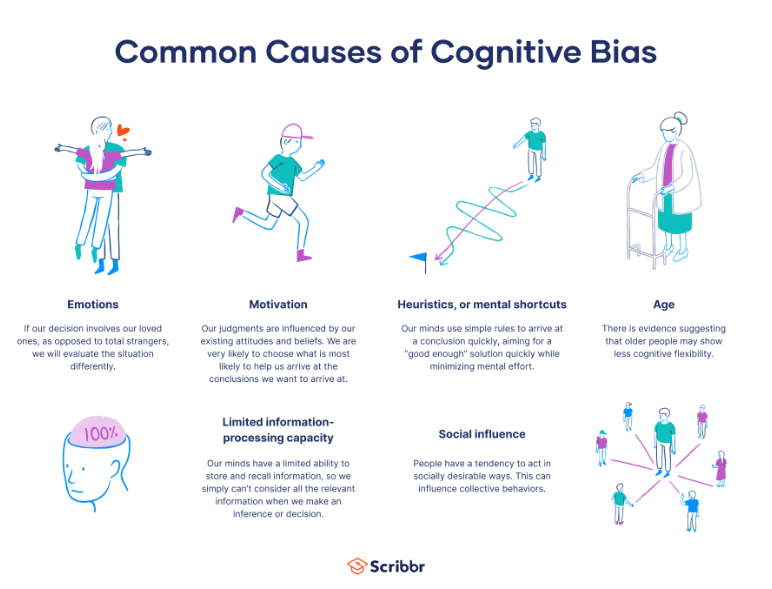
Cognitive biases are systematic patterns of deviation from norm or rationality in judgment. They arise from various mental shortcuts that our brains employ when processing information, often leading to perceptual distortion, inaccurate judgment, or illogical interpretation. In the retail industry, where decisions are made rapidly and based on complex datasets, these biases can skew analytics and lead to strategic missteps.
Recognizing and mitigating cognitive biases is crucial in data-driven decision-making retail because it directly influences the accuracy of business insights and decisions. When unchecked, these biases can cause even the most data-rich strategies to falter, leading to costly errors and missed opportunities. For retail executives, the ability to identify and counteract these biases is not merely an analytical skill but a competitive necessity that can define market success.
Retail leaders can enhance their decision-making processes by fostering an awareness of cognitive biases. This awareness not only helps in achieving more balanced and informed decisions but also in building a more resilient business capable of adapting to market dynamics and consumer behaviors effectively.
The Top 10 biases impacting retail decision-making
| Bias | Description | Common Examples in Retail | How to Overcome |
|---|---|---|---|
| Confirmation Bias | The tendency to search for, interpret, favor, and recall information that confirms one’s pre-existing beliefs or hypotheses. | Preferring data that supports an existing belief about a marketing strategy’s effectiveness while ignoring contrary data. | Actively seek out and consider contradictory information and diverse perspectives. |
| Anchoring Bias | The common human tendency to rely too heavily on the first piece of information offered when making decisions. | Using initial sales data as a baseline for future expectations without accounting for changing conditions. | Deliberately challenge initial data points and seek additional sources of information. |
| Overconfidence Bias | When decision-makers overestimate their own ability to make accurate predictions or possess certain knowledge. | Overestimating a product’s market success based on intuition rather than detailed market analysis. | Implement systematic feedback loops to review decisions and encourage continuous learning. |
| Information Bias | The tendency to seek information even when it does not affect action; more information is not necessarily better. | Collecting excessive customer feedback without a clear strategy for action or improvement. | Focus on actionable data and critical metrics that directly influence business decisions. |
| Bandwagon Effect | The propensity to do (or believe) things because many other people do the same. | Adopting strategies simply because they are industry trends without considering if they are beneficial for the specific context. | Conduct independent analysis to evaluate the relevance and potential impact of trends before adoption. |
| Status Quo Bias | A preference for the current state of affairs, resisting changes or new ideas. | Continuing with outdated marketing strategies because they are familiar and perceived as less risky. | Promote a culture of experimentation and reward initiatives that challenge the status quo. |
| Loss Aversion | The tendency to prefer avoiding losses to acquiring equivalent gains. | Reluctance to discontinue a failing product line due to the initial investment rather than future potential. | Quantify the opportunity cost of inaction and make decisions based on potential gains versus losses. |
| Survivorship Bias | Focusing on successes while ignoring failures, leading to inaccurate conclusions about reality. | Analysing only the best-performing stores without considering why other stores are underperforming. | Include a comprehensive data set in analysis to ensure all perspectives are considered. |
| Optimism/Pessimism Bias | The bias causes someone to believe they themselves are either more or less at risk of a negative event than they actually are. | Being overly optimistic about sales forecasts ignoring potential market downturns. | Use realistic and varied scenarios in planning to prepare for different future outcomes. |
| Recency Bias | The tendency to weigh the most recent information more heavily than older data. | Overvaluing the latest customer feedback and making swift changes without considering long-term trends. | Balance recent data with historical trends to make well-informed decisions. |
1. Confirmation bias
What it is: Confirmation bias represents a deep-seated inclination to favor information that aligns with our existing beliefs, while disregarding or devaluing inputs that challenge them. This bias affects our ability to perceive and interpret information objectively, often leading us to unwittingly select data that supports our preconceptions rather than questioning them.
Common examples in retail: Retail executives might prefer data that supports their existing belief in the effectiveness of a certain marketing strategy, ignoring evidence that contradicts this belief. Specifically, managers might continuously favor traditional advertising methods over digital ones because past successes validate their preferences, despite emerging data showing digital’s higher ROI.
How to overcome: In the pursuit of effective data-driven decision-making in retail, it’s crucial to actively seek out and consider information that challenges your current beliefs. This approach ensures a more comprehensive understanding of the data, leading to better-informed decisions. Implement practices such as peer reviews and encourage a culture of healthy skepticism to ensure diverse perspectives are considered. Use structured decision-making processes that require evidence to support all assertions, promoting a balance of supporting and conflicting information.
Tools:
- Peer reviews
- Structured decision-making processes
2. Anchoring bias

What it is: Anchoring bias occurs when individuals give disproportionate weight to the first piece of information they receive (the “anchor”) and then base all subsequent judgments and decisions on this initial piece of data. This often leads to skewed decision-making as the initial information may not always be the most relevant or accurate reference point.
Common examples in retail: Initial pricing strategies may heavily influence markdowns and sales strategies throughout the season, preventing adaptive pricing that could maximize revenue based on current market dynamics.
How to overcome: Use a range of data points to inform decisions. Regularly reset benchmarks, pricing, and forecasting strategies by incorporating a variety of market indicators and data points. Hold strategy reviews to adjust baselines and prevent outdated anchors from influencing new decisions. Lastly, for robust data-driven decision-making in retail, it’s vital to involve multiple sources of information to avoid over-reliance on initial data, ensuring a well-rounded analysis.
Tools:
- Reset benchmarks
- Reset pricing strategies
- Reset forecasting strategies
- Hold strategy reviews
- Avoid over-reliance on initial data

3. Overconfidence bias
What it is: Overconfidence bias involves an exaggerated belief in one’s own abilities or the accuracy of one’s forecasts, which can impair judgment and decision-making. This bias often leads to underestimating risks and overestimating outcomes, skewing the realistic assessment of various business situations.
Common examples in retail: Executives might overestimate a new product’s market success based on past successes, neglecting market research or consumer trend analyses that suggest otherwise.
How to overcome: Foster a culture of questioning and critical thinking. Regularly review and adjust forecasts and strategies based on actual outcomes versus initial expectations.
4. Information bias
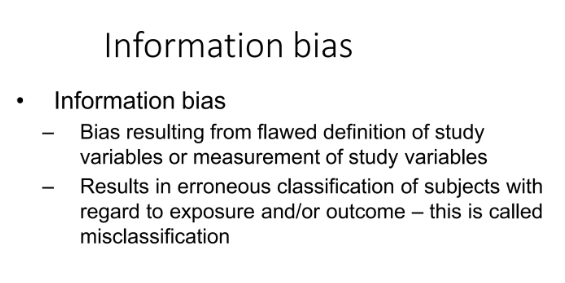
What it is: Information bias is the tendency to seek information even when it does not affect the decision-making process. This bias can lead to ‘analysis paralysis,’ where decision-makers gather excessive data, much of which may be irrelevant to the decisions at hand, potentially delaying action and clouding clear judgment.
Common examples in retail: Collecting extensive amounts of customer data without clear strategies for its use can lead to analysis paralysis, where no decision is made due to an overload of information.
How to overcome: Focus on actionable data and clearly define what you need to know to make a decision. Prioritize the quality of data over quantity by setting clear objectives for data collection by establishing key performance indicators (KPIs) that guide data collection efforts. By developing a focused approach that ties data-driven decision-making in retail directly to specific strategic decisions, retailers can enhance their processes, thereby reducing the temptation to collect irrelevant data.
Tools:
- Data quality over quantity
- Clear objectives for data collection
- Track data collection efforts with KPI’s
5. Bandwagon effect
What it is: The bandwagon effect describes the phenomenon where people do something primarily because others are doing it, not necessarily because it aligns with their own beliefs or because it is the most rational decision. In a business context, this can lead to ‘groupthink’ where innovation is stifled and decisions are made based on trend-following rather than strategic analysis.
Common examples in retail: Retailers may stock items similar to competitors without considering if these items meet the unique needs of their customer base, simply because these products are popular elsewhere.
How to overcome: Conduct independent market research to understand what truly resonates with your own customer demographic. Tailor inventory and marketing strategies to reflect unique customer insights rather than industry trends alone.
6. Status quo bias

What it is: Status quo bias is the preference to keep things the same or maintain a previous decision. This bias stems from a natural human resistance to change and comfort found in familiarity, which can prevent the adoption of new and potentially superior alternatives or innovations.
Common examples in Retail: Continuing to use outdated marketing techniques because they are familiar, even when new data suggests they are no longer effective.
How to overcome: Encourage experimentation and innovation within the organization to continuously improve data-driven decision-making in retail, fostering a culture that is adaptable and forward-thinking. Regularly review and question existing practices and be willing to adopt new strategies based on data-driven insights.
7. Loss aversion
What it is: Loss aversion is a principle from behavioral economics suggesting that the pain of losing is psychologically about twice as powerful as the pleasure of gaining. This bias can lead decision-makers to avoid risks that might result in a loss, even when there is a substantial potential gain on offer, skewing rational risk assessment.
Common examples in retail: Hesitation to explore new market opportunities or innovative product lines due to fear of potential failure, despite evidence suggesting a probable high reward.
How to overcome: Quantify potential risks and benefits. Make decisions based on a balanced understanding of both potential loss and gain, and develop contingency plans to manage possible setbacks.
8. Survivorship bias
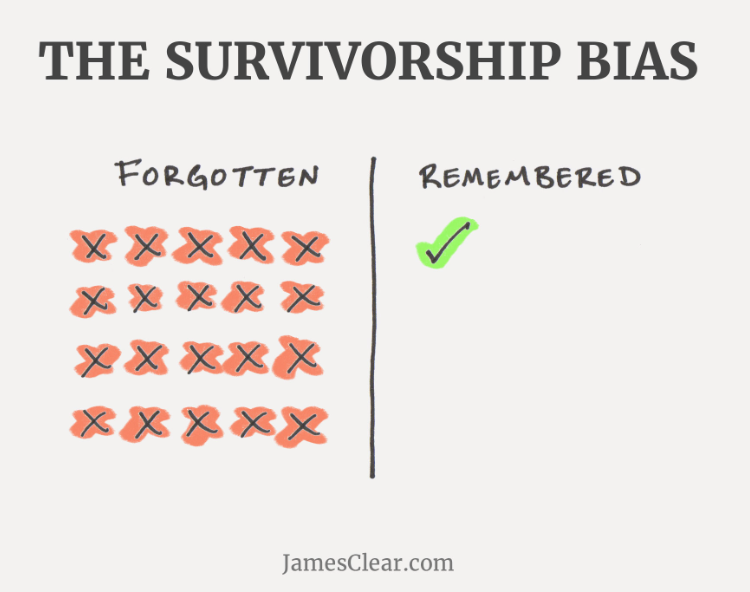
What it is: Survivorship bias involves focusing only on the successes or survivors in a particular area and ignoring those who failed. This bias can lead to overly optimistic beliefs and decisions because the failures—which can provide critical insights and learnings—are overlooked.
Common examples in retail: Analyzing only the best-selling products or most successful stores for insights, while ignoring underperforming ones that could offer crucial lessons.
How to overcome: Include data from both successful and unsuccessful cases to gain a more comprehensive view of the situation. This analytical approach aids in refining data-driven decision-making in retail by clarifying what strategies work, and which don’t while understanding the reasons behind each outcome.
9. Optimism/pessimism bias
What it is: This bias refers to the tendency to overestimate the likelihood of positive outcomes (optimism bias) or negative outcomes (pessimism bias) based on personal disposition rather than factual evidence. It affects decision-making by distorting risk assessment and expectation management.
Common examples in retail: Being overly optimistic about holiday sales forecasts based on past successes, and ignoring signs of an economic downturn that could dampen consumer spending.
How to overcome: Employ scenario planning and risk management strategies. Prepare for a variety of potential future conditions to ensure resilience regardless of market dynamics.
10. Recency bias
What it is: Recency bias is the propensity to give more weight to the most recent information or experiences, potentially at the expense of a longer-term or more balanced view. This bias can lead to short-sighted decisions that prioritize immediate realities over established trends or patterns.
Common examples in retail: Overvaluing the latest customer feedback or sales data, leading to rapid changes in strategy that may disregard long-term trends.
How to overcome: Ensure decisions are based on a comprehensive dataset that includes both recent and historical insights. Maintain a balanced view to prevent short-term fluctuations from distorting long-term strategy planning.
Implementing structured decision-making frameworks
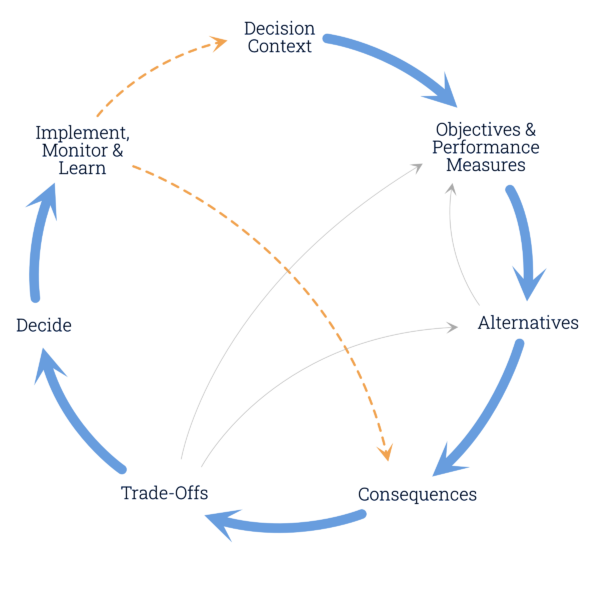
Structured decision-making frameworks are methodologies designed to streamline the decision-making process by setting clear, objective criteria and structured approaches. These frameworks guide retailers through a series of steps that help evaluate options based on data and predefined rules, thereby minimizing the influence of personal bias and enhancing the consistency and quality of decisions.
Key benefits for a retailer:
Benefit #1: Enhanced consistency and alignment with strategic goals
Structured frameworks ensure that every decision is aligned with the broader strategic objectives of the organization. For example, a retailer can use a decision matrix that scores potential new store locations based on factors such as expected foot traffic, local demographics, and alignment with brand image. This methodical approach ensures that each decision bolsters the company’s long-term goals, enhancing strategic consistency across all levels of the organization and solidifying the foundations of data-driven decision-making in retail.
Benefit #2: Increased decision-making speed
Structured decision-making frameworks can significantly speed up the decision-making process by reducing ambiguity and the need for lengthy deliberations. Retailers often face rapidly changing market conditions where speed is critical. For instance, a decision tree could be used to quickly determine whether to discount products based on inventory levels, sales velocity, and promotional calendar, enabling faster responses to market dynamics and operational efficiencies.
Benefit #3: Improved transparency and accountability
When decisions are made using a clear and structured approach, it enhances transparency and accountability within the organization. This can be particularly beneficial in a retail environment where decisions often need to be justified to stakeholders, including investors and board members. Using a framework like a weighted scoring system for product selection or vendor evaluation makes the decision process traceable and justifiable, fostering trust and confidence.
How ContactPigeon’s CDP can assist retailers in making data-driven decisions
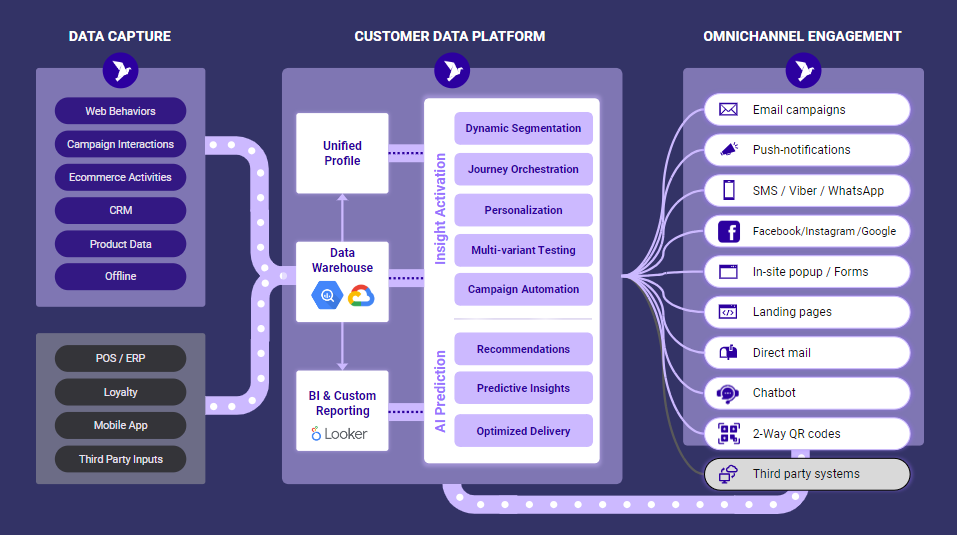
ContactPigeon’s Customer Data Platform (CDP) offers a robust solution for retailers aiming to refine their data-driven decision-making processes. By leveraging these capabilities, retailers can not only improve the precision of their marketing campaigns but also enhance operational efficiencies and customer engagement, ultimately driving sales and loyalty.
- Unified customer profiles: By integrating data from various sources, ContactPigeon creates detailed customer profiles, providing a comprehensive view of customer behaviors and preferences.
- Dynamic segmentation: Retailers can segment their customers based on real-time data, allowing for more targeted and effective marketing strategies.
- Omnichannel orchestration: The platform ensures a consistent customer experience across all channels, from in-store interactions to digital engagements.
- Predictive analytics: Leveraging AI, ContactPigeon offers predictive insights that help anticipate customer needs and future behaviors, optimizing marketing efforts and inventory management.
- Personalization and recommendation engines: These features enable retailers to deliver personalized content and product recommendations, enhancing the shopping experience and boosting customer satisfaction.
- Real-time APIs: These allow for seamless integration and synchronization of data across the retailer’s tech stack, ensuring that all systems are up-to-date and reflective of the latest customer interactions.
Conclusion: Cultivating an analytical mindset in retail
The retail industry is rapidly evolving, and informed, data-driven decision-making in retail is more crucial than ever, necessitating a keen focus on accurate and timely data analysis. Recognizing and overcoming cognitive biases is essential in ensuring that decision-making processes are not only swift but also accurate and reflective of real market conditions. Retailers who cultivate an analytical mindset can significantly enhance their strategic initiatives, leading to improved operational efficiencies and increased profitability.
Taking proactive steps to implement training and tools that support bias mitigation and enhanced decision-making is vital. ContactPigeon’s Customer Data Platform exemplifies thought leadership in data collection and actionable omnichannel customer engagement, offering retailers a powerful tool to navigate the complexities of modern consumer interactions. By leveraging predictive analytics, unified customer profiles, and advanced segmentation, ContactPigeon enables retailers to deliver personalized, customer-centric experiences that drive engagement and sales.
We encourage you to witness firsthand the capabilities of ContactPigeon’s CDP. Schedule a free live demo today and explore how you can transform your data into actionable insights that propel your retail business forward. Embrace the power of a data-driven approach and lead your business to new heights of success.

Let’s Help You Scale Up




![Benchmarking Growth Strategies of Top Fashion Retailers [Study]](https://blog.contactpigeon.com/wp-content/uploads/2025/11/top-fashion-retailers.jpg)